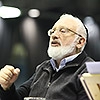As If We Put On Glasses And Begin To See
 2,000 years ago, the Temple was destroyed and the people of Israel began their wanderings around the world. We got used to living in exile among other nations and often even succeeded in doing so. Sometimes, on the contrary, the nations of the world settled scores with us. Hatred of the Jews steadily grew, one wave rose after another, and recently a tsunami of anti-Semitism has been rising.
2,000 years ago, the Temple was destroyed and the people of Israel began their wanderings around the world. We got used to living in exile among other nations and often even succeeded in doing so. Sometimes, on the contrary, the nations of the world settled scores with us. Hatred of the Jews steadily grew, one wave rose after another, and recently a tsunami of anti-Semitism has been rising.
The problem is that we are not correcting the shattering. Anti-Semitism is the result of our neglect of the possibility of achieving correction. The exile ended, but only in potential, not in practice. Many would dream of leaving the land of Israel and returning to exile. After all, holiness is only in the unity that we can build between us. Without unity, there is no holiness, and we are still in destruction.1
In fact, the destruction was a correction. You cannot call it corruption because there was still nothing corrected that could be corrupted. It was the shattering of the boundary between the receiving and bestowing desires, the boundary between the Creator and the created being, between the properties of the Creator and the created being. Therefore, it was only for the sake of correction.
The desire to enjoy existed before the shattering, only it was hidden. After it was revealed, the created being could already begin to work on it and rise to the Creator. Each time the creature reveals its disparity with the Creator, which gives him the opportunity to correct this discrepancy and get closer to the Creator.
This disparity already existed before, but now it has been revealed. That is, there is a revelation with respect to the created being, as if we put on glasses and begin to see the malfunction that we did not notice before.2
The destruction of the Temple represents the merging of Bina with Malchut. Therefore, there were two destructions, according to the two levels in the spiritual Partzufim: Dalet-Gimel (4/3) and Gimel-Bet (3/2). The first Temple was destroyed at the level of Mochin de Haya, and the Second—at the level of Mochin de Neshama. Therefore, the destruction of the First Temple was much more powerful and significant. But the destruction of the Second Temple was more significant in that it meant a complete exit from spirituality.
The First Temple is a spiritual union in which all desires are combined together with the intention of bestowing to the Creator at the level of Mochin de Haya. There was a huge struggle between people and each one within himself for the sake of maintaining this unity and not falling. But egoism was steadily growing and in the end, the shattering did occur. The people of Israel went into exile; that is, there was a gap between the levels—the spiritual Partzuf exhausted itself. After the exile, the people were returning to spirituality, building a new Temple. (The First Temple is like Malchey DHGT [Daat, Hesed, Gevura, Tifferet] and the Second Temple is Malchey TNHYM [Tifferet, Netzah, Hod, Yesod, Malchut] in the world of Nekudim, which were broken).
The destruction of the Second Temple was already the final exit from spirituality—all went into intention for their own sake. Since then, the whole nation except for some special people, Kabbalists, entered the process of the continuous descent of generations.
It is impossible to compare the generations that lived immediately after the destruction of the First or the Second Temple with our contemporaries. They felt a much greater connection with each other. Holiness still illuminated them from afar and the sparks from the destruction of the previous Temple fell and made an impact. Therefore, there were still great people in those generations even after the destruction of the Second Temple. We see what great books they left for us: Mishna and Talmud.
Many were still in spiritual attainment. The fall did not happen instantly. The light was exiting the Partzuf gradually, until we were almost in total darkness by the time of the Ari.
From the time of the Baal Shem Tov and onward, the awakening from below began. Baal Shem Tov did a great job reviving spirituality, and he was followed by Baal HaSulam. There were other Kabbalists who lived in the time between them. The last great Kabbalist of our time was Rabash who left us the whole method of correction that we use today.3
From the 2nd part of the Daily Kabbalah Lesson 7/21/19, “Ninth of Av”
1 Minute 9:50
2 Minute 12:50
3 Minute 18:58
Related Material:
Mourn The Temple That Hasn’t Yet Been Built In Our Hearts
New Life #613 – A Temple That Is Built Between Us
How Do You Define Anti-Semitism?







Discussion | Share Feedback | Ask a question